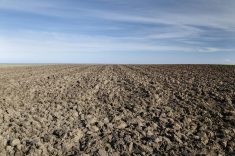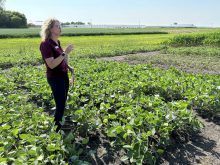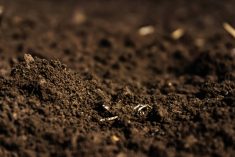Disappearing shelterbelts and blackened fields have some wondering if the soil conservation lessons learned during the ‘Dirty ’30s’ dust bowl are being forgotten.

“From the edge of Fargo to the edge of Winnipeg I did not see one flake of white snow on my way up yesterday (Jan. 31),” Daryl Ritchison, interim director of the North Dakota Agricultural Weather Network at North Dakota State University told the Manitoba Soil Science Society’s 61st annual meeting in Winnipeg Feb. 1. “It was all greyscale.”
The little bit of snow in the ditches was covered by soil blown from fields.
“There is a risk that we are forgetting some of the lessons of the 1930s,” Jim Tokarchuk, executive director of the Soil Conservation Council of Canada told the meeting. “I think anecdotally we are all seeing changes in how we are treating land. There is less covering. I see that. I drive across the Prairies four or five times a year. There’s more tillage for some reason.”
In an interview later Tokarchuk warned against complacency.
“Let’s make sure we use the lessons of the past,” he said.
More research is needed on why there’s more tillage and the economic and agronomic impact, he said.
Important challenge
With the world’s population projected to double to nine billion by 2050, the demand for food will increase, putting even more pressure on fragile soils.
Presumably shelterbelts are being removed because they are dead or dying, and to make fields more accessible for larger equipment.
If farmers are working their land more it could be to get warmer soils earlier in the spring or to help dry out wet soils for faster seeding.
The 1930s drought across the central plains of North America, including the Canadian Prairies, was severe, but it was a rare event, University of Manitoba soil scientist David Lobb said in an interview. Nothing as extreme has occurred since.
Read Also

Manitoba sclerotinia picture mixed for 2025
Variations in weather and crop development in this year’s Manitoba canola fields make blanket sclerotinia outlooks hard to pin down

However, some might make the case that since devastating dust storms and soil banks haven’t returned even though there have been drier years than in the 1930s, soil conservation practices, such as reduced and zero tillage and permanent cover on the most vulnerable land, are working.
While dirty snow looks bad, more soil is eroded by tillage and water than wind, Lobb said.
“In-field investigations, and out-field investigations, suggest the levels (of soil blown out of fields) predicted are extraordinarily exaggerated,” Lobb said.
Lobb’s research shows most of the soil eroded from Manitoba knolls is caused by tillage and the most of that soil is still in lower parts of the same field. Returning that soil to hilltops can be an economic way for farmers to increase their soil health, he said.
Conservation tillage is just the start of improving soil productivity by reducing further erosion, Lobb said. Improving soil productivity requires increasing organic matter, which takes decades and longer, he added.
Dying of dust
Several years ago Ritchison interviewed 15 people in North Dakota who lived through the dust bowl. He was told many thought it was the end of the world.
“In this group (of people who lived through it) I would not get anybody arguing with me that… what happened (in the U.S.) was the worst man-made ecological disaster in the country,” Ritchison said. “I think it’s really hard to argue against that.
“They were trying to keep the dust out because literally hundreds and hundreds of people on the plains died from dust pneumonia. Very young people died, very old people died.”
When Ritchison asked one elderly man what he recalled about the 1930s, the first thing was that his father said the disc was the worst invention ever.
The plow was cursed too for quickly drying out the turned-over soil.
With so little rain very little grew but tumbleweeds — Russian thistle and kochia. They would pile up against fencelines, which then would catch the blowing soil creating snow-like soil drifts.
During severe dust storms it was so dark people lit lamps in the daytime to see.
On July 6, 1936, Mrs. R.S. Armstrong, a North Dakota COOP (weather) observer reported the temperature hit 121 F in Steele, N.D., setting a record.
“Hot winds. Leaves and shrubbery cooked,” she reported.




















